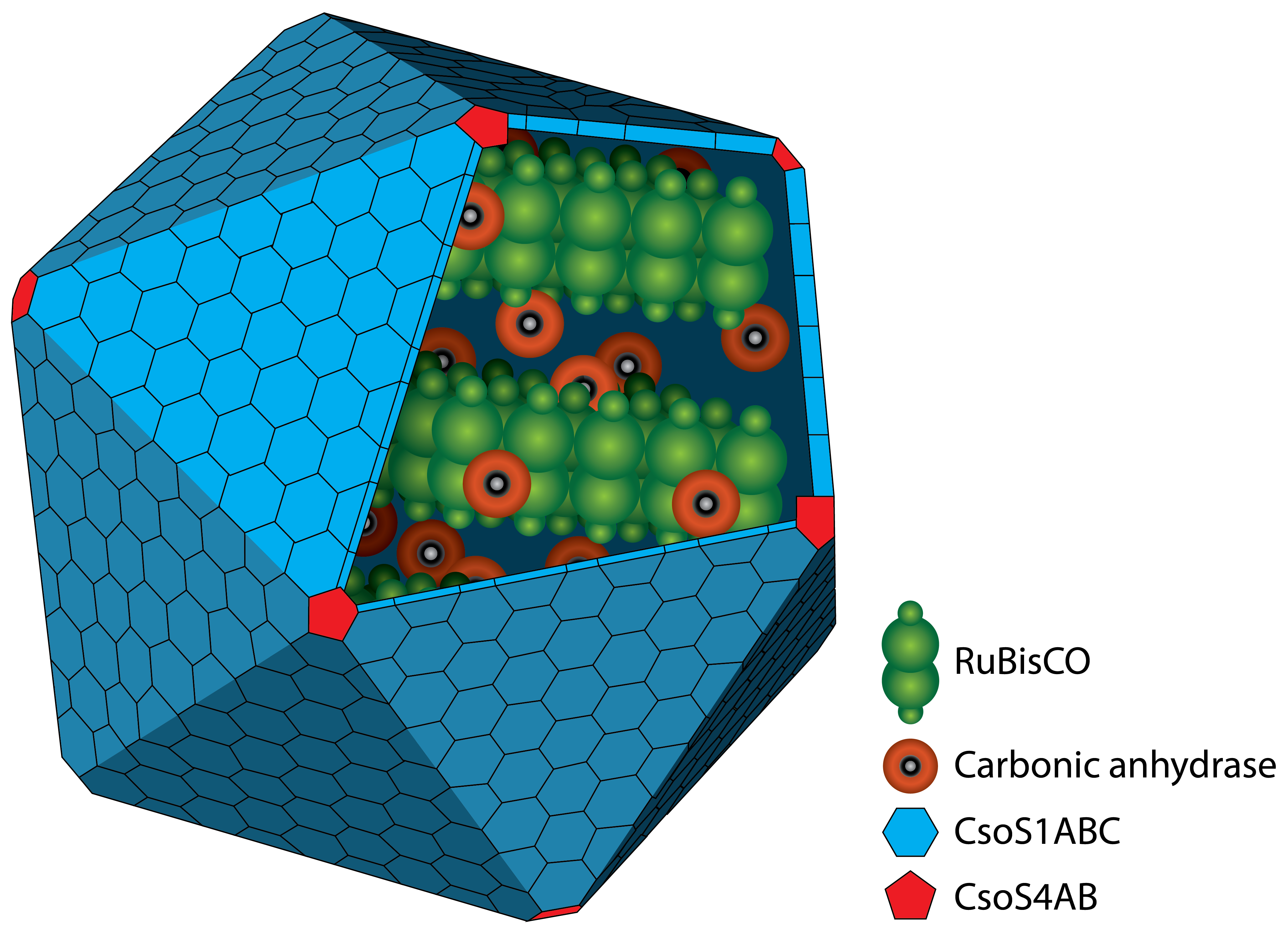Team:Bielefeld-CeBiTec/Project/CO2-fixation/Carboxysome
From 2014.igem.org
(some mistakes removed) |
|||
| Line 74: | Line 74: | ||
</div> | </div> | ||
<p>A carboxysome is a bacterial microcompartiment (BMC) surrounded by a protein shell. Carboxysomes (CB) play an essential role in carbon fixation mechanism, as they are the enzym-containing organelles for these metabolic pathways (<a href="#bonacci2011">Bonacci et al., 2011</a>) (<a href="#shively1973">Shively et al., 1973</a>). The first carboxysomes were discovered in 1956, and purified carboxysomes were first characterized in 1973 by <a href="#shively1973">Shively et al., 1973</a>. | <p>A carboxysome is a bacterial microcompartiment (BMC) surrounded by a protein shell. Carboxysomes (CB) play an essential role in carbon fixation mechanism, as they are the enzym-containing organelles for these metabolic pathways (<a href="#bonacci2011">Bonacci et al., 2011</a>) (<a href="#shively1973">Shively et al., 1973</a>). The first carboxysomes were discovered in 1956, and purified carboxysomes were first characterized in 1973 by <a href="#shively1973">Shively et al., 1973</a>. | ||
| - | Carboxysomes, as BMCs, are formed by different shell proteins, surrounding an enzyme-containing lumen, which is rigorous seperated from the cytoplasm. Thus, the possibility is given to enable reaction pathways incongruous with the cytoplasm. | + | Carboxysomes, as BMCs, are formed by different shell proteins, surrounding an enzyme-containing lumen, which is rigorous seperated from the cytoplasm. Thus, the possibility is given to enable reaction pathways incongruous with the conditions in the cytoplasm. |
| - | The protein shell consists of two different types of proteins. Pentamers are used for the vertices of the icosaeder and hexamers for the facets. Carboxysomes are between 80 and 120 nm in diamter (<a href="#bonacci2011">Bonacci et al., 2011</a>). In the interior, there are two different types of enzymes. On the one hand there is the | + | The protein shell consists of two different types of proteins. Pentamers are used for the vertices of the icosaeder and hexamers for the facets. The main constituent of the shell is the CsoS1A protein, 9.9 kDa large, which makes arround 13 % of the total protein mass). Carboxysomes are between 80 and 120 nm in diamter (<a href="#bonacci2011">Bonacci et al., 2011</a>). In the interior, there are two different types of enzymes. On the one hand there is the |
<a href="https://2014.igem.org/Team:Bielefeld-CeBiTec/Project/CO2-fixation/CalvinCycle" target="_blank">RuBisCo</a> which catalyses the carboxylation or oxygenation of ribulose-1,5-bisphosphate. On the other hand there is the carbonic anhydrase which converts hydrogen carbonate (HCO3<sup>-</sup>) to carbon dioxide. The resulting carbon dioxide is the substrate for the RuBisCO.<br> | <a href="https://2014.igem.org/Team:Bielefeld-CeBiTec/Project/CO2-fixation/CalvinCycle" target="_blank">RuBisCo</a> which catalyses the carboxylation or oxygenation of ribulose-1,5-bisphosphate. On the other hand there is the carbonic anhydrase which converts hydrogen carbonate (HCO3<sup>-</sup>) to carbon dioxide. The resulting carbon dioxide is the substrate for the RuBisCO.<br> | ||
Revision as of 11:06, 15 October 2014
CO2 Fixation
Carboxysome
A carboxysome is a bacterial microcompartiment (BMC) surrounded by a protein shell. Carboxysomes (CB) play an essential role in carbon fixation mechanism, as they are the enzym-containing organelles for these metabolic pathways (Bonacci et al., 2011) (Shively et al., 1973). The first carboxysomes were discovered in 1956, and purified carboxysomes were first characterized in 1973 by Shively et al., 1973.
Carboxysomes, as BMCs, are formed by different shell proteins, surrounding an enzyme-containing lumen, which is rigorous seperated from the cytoplasm. Thus, the possibility is given to enable reaction pathways incongruous with the conditions in the cytoplasm.
The protein shell consists of two different types of proteins. Pentamers are used for the vertices of the icosaeder and hexamers for the facets. The main constituent of the shell is the CsoS1A protein, 9.9 kDa large, which makes arround 13 % of the total protein mass). Carboxysomes are between 80 and 120 nm in diamter (Bonacci et al., 2011). In the interior, there are two different types of enzymes. On the one hand there is the
RuBisCo which catalyses the carboxylation or oxygenation of ribulose-1,5-bisphosphate. On the other hand there is the carbonic anhydrase which converts hydrogen carbonate (HCO3-) to carbon dioxide. The resulting carbon dioxide is the substrate for the RuBisCO.
Generally, there are two different types of CBs found, called α-type and β-type carboxysomes. This classification is based on the differences in their component proteins and organisation of their corresponding genes.
α-type carboxysomes are found in α-cyanobacteria like some Synechococcus species or the chemoautotroph model organism Halothiobacillus neapolitanus. This type of carboxysome contains the type I RuBisCo. Furthermore the respective genes for the carboxysome are arranged in a single operon. In β-type carboxysomes occurs the type II RuBisCo, containing no small subunits. In contrast to α-type carboxysomes, the genes are localisated in multiple gene clusters. (Bonacci et al., 2011) (Yeates et al., 2008) A possible difference in functionality between both types of carboxysomes is not fully understood (Yeates et al., 2008).
The advantage of the microcompartiment is that the concentration of carbon dioxide inside can be much higher than outside which increases the efficiency of the RuBisCO-catalyzed reaction.
There are two different types of carboxysomes which are classified by the habitat of the organism. It is found in all cyanobacteria and some chemolitoautotrophic bacteria. A deletion mutant for a single gene of the cluster results in a conditionally lethal phenotype which requires high concentrations of carbon dioxide.
References
-
Bonacci et al., 2011. Modularity of carbon-fixing protein organelle. PNAS, vol. 109, pp. 478-483
-
Shively et al., 1973. Functional organelles in Prokaryotes: Polyhedral Inclusions (Carboxysomes) of Thiobacillus neapolitanus. Science, vol. 182, pp. 584-586
-
Yeates et al., 2011. Protein-based organelles in bacteria: carboxysomes and related microcompartments. Nature Reviews Microbiology, vol. 6, pp. 681-691
 "
"

